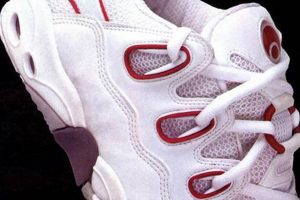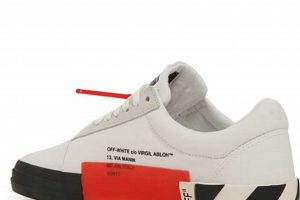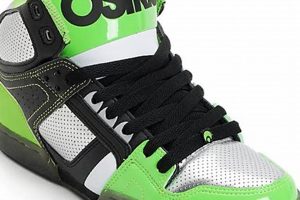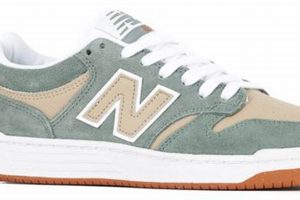Footwear designed specifically for skateboarding gained significant traction during the final decade of the 20th century. These items, often characterized by their durable construction, flat soles for board grip, and padded collars for ankle support, became synonymous with the burgeoning skate culture. Examples include models from brands that rose to prominence through their association with influential skateboarders and skate videos.
The widespread adoption of this specialized footwear transcended mere functionality. It represented a cultural shift, signifying belonging and shared identity within a rapidly growing subculture. Its popularity extended beyond the skateboarding community, becoming a fashion staple embraced by a broader audience, impacting design trends and influencing the athletic footwear industry. The design innovations offered enhanced performance, while the cultural impact solidified its position as a defining element of the era.
Subsequent sections will delve into specific brands that defined the era, exploring the technical innovations and stylistic trends that shaped this iconic footwear category, and examine the enduring legacy of this style within contemporary fashion and skateboarding.
Essential Considerations for Selecting Retro Skate Footwear
Proper selection requires careful attention to detail. By considering these key aspects, the lifespan and functionality of the footwear can be maximized.
Tip 1: Assess Sole Durability. The sole should exhibit robust abrasion resistance, as it is the primary point of contact with the skateboard. Vulcanized rubber soles, known for their superior grip and longevity, are preferred.
Tip 2: Evaluate Upper Material. Opt for suede or reinforced canvas uppers. These materials provide a balance of durability and flexibility, crucial for withstanding the rigors of skateboarding.
Tip 3: Prioritize Padding and Ankle Support. Sufficient padding around the ankle and tongue areas is essential for impact absorption and injury prevention. Look for models with high-top designs or reinforced collars.
Tip 4: Inspect Stitching Quality. Double or triple stitching in high-stress areas, such as the ollie patch and toe cap, ensures structural integrity and prolonged wear.
Tip 5: Consider Ventilation. Adequate airflow is vital for maintaining comfort and preventing moisture buildup during extended use. Perforated panels or breathable linings can improve ventilation.
Tip 6: Research Brand Reputation. Established manufacturers with a proven track record in skateboarding footwear often offer superior quality and performance. Look for brands historically associated with the skateboarding subculture.
Tip 7: Examine Weight and Flexibility. A balance between weight and flexibility is crucial. Footwear that is too heavy can hinder maneuverability, while overly flexible models may lack sufficient support.
Following these guidelines will increase the probability of procuring footwear that meets the demands of skateboarding, while capturing the style of a specific decade.
The subsequent analysis will focus on the evolution of design elements and the continuing relevance of these classic designs in the current skateboarding landscape.
1. Durability
Durability in the context of footwear designed for skateboarding during the 1990s was not merely a desirable attribute, but a fundamental requirement. The abrasive nature of the sport demanded resilient construction to withstand constant friction and impact.
- Reinforced Uppers
The upper portion of the footwear frequently incorporated reinforced materials such as suede, leather, or heavy-duty canvas. These materials offered increased resistance to tearing and abrasion compared to standard fabrics. The strategic placement of additional layers in high-wear areas, like the ollie patch, further enhanced longevity. The use of these materials allowed skater shoes to survive the day to day use and abuse.
- Vulcanized Rubber Soles
Vulcanization, a process that strengthens rubber, was commonly employed in the manufacturing of the soles. This resulted in a highly abrasion-resistant outsole capable of withstanding repeated contact with the skateboard deck and pavement. The thickness and tread pattern of the sole also contributed to its overall durability, providing both grip and protection against wear.
- Robust Stitching
High-quality stitching was crucial in binding the various components of the footwear together. Double or triple stitching along seams and stress points minimized the risk of separation or tearing under the forces exerted during skateboarding maneuvers. Durable thread materials further enhanced the integrity of the stitching.
- Protective Elements
Many models incorporated additional protective elements, such as reinforced toe caps and heel counters, to safeguard vulnerable areas from impact and abrasion. These features not only extended the lifespan of the footwear but also provided enhanced protection for the wearer’s feet. This further demonstrates the need for rugged footwear that was equipped with the ability to protect the skaters during intense moments and movements.
These design elements collectively contributed to the exceptional durability synonymous with skateboarding footwear. The ability to withstand the rigors of the sport was essential not only for performance but also for the footwear to be deemed worthwhile.
2. Grip
In the context of skateboarding footwear from the 1990s, grip transcends mere traction. It represents a critical performance attribute, facilitating board control and maneuverability necessary for executing technical tricks and maintaining stability. The design and materials of the sole played a pivotal role in achieving optimal grip.
- Vulcanized Rubber Composition
The dominant material for soles was vulcanized rubber, prized for its high coefficient of friction. This inherent stickiness allowed for a secure bond between the footwear and the skateboard deck’s grip tape. Variations in rubber compounds influenced the degree of grip, with softer compounds generally offering superior adherence but potentially reduced durability. This made selecting the right material one of the most important things when it came to producing skater shoes in the 90s.
- Tread Pattern Design
The tread pattern molded into the sole’s surface contributed significantly to grip performance. Herringbone, waffle, and diamond patterns were common, each offering a unique combination of surface area contact and channel depth for water displacement. Deeper tread patterns provided enhanced grip in wet conditions, while smoother patterns prioritized board feel. The tread patterns had to be well designed or else the user may slip during usage.
- Sidewall Construction
The design of the sole’s sidewall influenced grip during board maneuvers that involved contact with the edge of the sole. A textured or slightly extended sidewall increased the surface area available for grip when the skateboard was angled, improving control during grinds and slides. Without this design, maneuvers could have been harder to execute or even fail when attempted by the user.
- Cupsole vs. Vulcanized Sole Debate
While vulcanized soles were prevalent, cupsole designs also existed. Cupsole construction involved stitching or gluing the upper to a pre-molded sole unit. Cupsole soles typically offered greater impact protection and support, but often sacrificed some board feel and flexibility compared to vulcanized soles. Vulcanized rubber soles were more durable and cheaper to make. Cupsole did not come into play until later on in time, after the vulcanized models hit the market.
The interplay between rubber compound, tread pattern, and sole construction dictated the overall grip performance of skateboarding footwear. The selection of these features reflected a compromise between board feel, durability, and the specific needs of the skateboarder. It marked an era in skateboarding where specialized footwear became an integral part of the skateboarding experience, influencing both performance and style.
3. Padding
Padding in footwear intended for skateboarding during the 1990s served a critical function beyond mere comfort; it acted as a primary defense against the high-impact forces inherent in the sport. The frequent landing of jumps and execution of tricks placed considerable stress on the feet and ankles. Inadequate protection could result in injuries such as contusions, sprains, or even fractures. Therefore, the incorporation of substantial padding in key areas became a defining characteristic of skateboarding footwear of that era.
The strategic placement of padding directly correlated with areas of highest impact. The tongue, often thickly padded, shielded the top of the foot from lace pressure and potential impacts from the skateboard. Ankle collars, typically featuring dense foam padding, provided crucial support and protection against ankle rolls and abrasions during slides or falls. The insole, often constructed with shock-absorbing materials like polyurethane or EVA foam, mitigated impact forces transmitted through the sole. For example, models popularized by influential skaters often featured exceptionally thick tongue and collar padding, reflecting the demanding nature of their skateboarding styles. These design choices, while sometimes contributing to a bulkier aesthetic, prioritized safety and allowed skaters to push the boundaries of their abilities with reduced risk of injury.
The emphasis on padding reflects a growing awareness of the biomechanics of skateboarding and the need to mitigate potential injuries. Its prominence in skateboarding footwear contributed to the evolution of the sport, enabling skaters to attempt more daring maneuvers and progress at a faster rate. Although contemporary skateboarding footwear may feature more streamlined designs, the fundamental principle of providing adequate impact protection remains a cornerstone of the industry, tracing its roots back to the padded designs of the 1990s. The legacy of the decade’s approach to padding serves as a reminder of the importance of prioritizing safety and performance in athletic footwear design.
4. Style
The aesthetic qualities of skateboarding footwear became inseparable from their function in the 1990s. Style considerations extended beyond mere decoration, influencing design decisions related to silhouette, color palettes, and branding. The visual presentation of the footwear communicated a skater’s affiliation and personal identity within the subculture. For instance, the adoption of specific color combinations or the prominent display of brand logos served as visual cues, signaling alignment with particular skateboarding crews, music genres, or regional styles. The bulky silhouettes of early models, often featuring contrasting color panels and bold branding, reflected a rejection of mainstream athletic footwear norms. The style became a method for skaters to show themselves, and was the first thing that drew many people in.
The evolution of styles reflected the diversification of skateboarding itself. As the sport progressed from vert ramp skating to street skateboarding, footwear designs became more streamlined and technically focused. Lower-profile models with improved board feel gained prominence. Colorways transitioned from bright, contrasting schemes to more subdued, monochromatic palettes, reflecting a shift towards a more understated aesthetic. The design shifted as the sport changed, and the skater’s aesthetic and clothing shifted along with it. Brand collaborations with artists and musicians further blurred the lines between skateboarding and other cultural spheres, introducing new stylistic elements and expanding the appeal of these skater styles to a wider audience.
The stylistic significance of footwear from the decade endures to this day, influencing contemporary skateboarding fashion and inspiring retro-inspired designs. Its influence is not just a matter of aesthetics, but a historical marker that encapsulates the cultural energy of a specific moment in time, symbolizing both the rebellious spirit and the creative innovation that defined 1990s skateboarding. The fusion of function and aesthetic is one of the key takeaways when observing the evolution of these shoes.
5. Branding
Branding played a pivotal role in the rise and cultural impact of skateboarding footwear during the 1990s. It extended beyond simple logo placement; it represented a complex interplay of athlete endorsement, product design, and targeted marketing that shaped consumer perceptions and drove sales.
- Athlete Endorsement
Manufacturers collaborated with prominent skateboarders to design signature models and feature them in advertising campaigns. The association with respected athletes lent credibility and desirability to the brand. The visibility provided by endorsements amplified reach, and shaped consumers’ ideals in respect to what styles were desirable.
- Logo Visibility and Placement
The strategic placement of brand logos was a key element. Prominent logos, often rendered in bold colors and graphic styles, served as visual identifiers and status symbols. The consistent and strategic placement of such logos reinforced brand recognition and affinity within the skateboarding community and beyond. The placement of the logo signaled a visual code to other skaters, and was an expression of one’s allegiance.
- Marketing and Advertising Strategies
Advertising campaigns frequently targeted skateboarding subculture through print ads in skateboarding magazines and sponsorships of skateboarding events. Brands cultivated an image that resonated with skateboarders, portraying a sense of authenticity, rebellion, and technical prowess. These strategies shaped purchasing decisions.
- Brand Identity and Authenticity
Brands that successfully established a strong identity and maintained a reputation for quality and innovation gained a competitive advantage. Authenticity, often demonstrated through a genuine commitment to the skateboarding community, fostered customer loyalty. This helped set brands apart from the competitors on the market.
In summary, the effectiveness of branding in the 1990s skateboarding footwear market depended on a holistic approach that encompassed athlete endorsement, logo visibility, targeted marketing, and a commitment to brand authenticity. These elements contributed to the creation of highly sought-after products that transcended mere functionality, becoming symbols of status and belonging within a vibrant subculture.
6. Evolution
The progression of skateboarding footwear throughout the 1990s was not merely a series of incremental design changes, but a reflection of the evolving needs and aesthetic preferences within the skateboarding community. Technical innovations, material advancements, and shifting cultural influences coalesced to shape the trajectory of the footwear.
- Shift from High-Tops to Low-Profiles
Early in the decade, high-top designs dominated, providing substantial ankle support for vert ramp skating. As street skateboarding gained prominence, lower-profile models offering enhanced board feel and maneuverability emerged. This transition reflected a change in the demands placed on the footwear by different skateboarding styles. Examples include the gradual adoption of slimmer silhouettes by brands that initially specialized in bulkier, heavily padded designs.
- Material Innovations and Performance Enhancements
Manufacturers experimented with new materials to improve durability, grip, and impact absorption. Advancements in vulcanized rubber compounds led to improved sole performance. The incorporation of lightweight cushioning materials in midsoles enhanced comfort and reduced fatigue. The development and implementation of reinforced ollie patches and toe caps prolonged the lifespan of the footwear, particularly for street skaters who subjected them to intense abrasion. This demonstrates the continued pursuit of the balance between providing comfort, and retaining the integrity of the skater shoes.
- Influence of Skateboarding Culture and Fashion Trends
The aesthetic of skateboarding footwear evolved in tandem with broader cultural trends. Bold color combinations and oversized logos prevalent in the early 1990s gave way to more subdued color palettes and minimalist branding as the decade progressed. The influence of music genres such as grunge and hip-hop also impacted footwear design. Collaborations between skateboarding brands and artists or musicians further blurred the lines between skateboarding and other cultural spheres, influencing both design and consumer appeal. It was this influence and collaboration that pushed skater shoes to the next level.
- Specialization and Segmentation of the Market
As skateboarding matured, manufacturers began to cater to specific niches within the sport. The introduction of models designed specifically for vert skating, street skating, or park skating reflected a deeper understanding of the unique demands of each discipline. This segmentation of the market allowed for greater customization and optimization of footwear for specific performance requirements. It was this customization that helped skaters perform specific actions, and increased the demand for skater shoes on the market.
These facets of evolution underscore the dynamic relationship between skateboarding footwear and the ever-changing landscape of the sport and its surrounding culture. The design shifts, material innovations, and cultural influences all contributed to the transformation of the skater shoes.
Frequently Asked Questions
The following section addresses common inquiries regarding skateboarding footwear prevalent during the 1990s. These questions aim to clarify key characteristics, historical context, and enduring relevance of this iconic footwear category.
Question 1: What were the defining features of 1990s skateboarding footwear?
Characteristics include durable construction utilizing suede or reinforced canvas uppers, vulcanized rubber soles for enhanced grip, padded tongues and collars for impact protection, and robust stitching for longevity. Distinctive design elements, such as bold color combinations and prominent branding, were also prevalent.
Question 2: Which manufacturers were most influential?
Several brands achieved prominence, including Etnies, Vans, Airwalk, DC Shoes, and S Footwear. These manufacturers were often associated with influential skateboarders and skateboarding videos, shaping consumer preferences and driving market trends.
Question 3: How did functionality influence the design?
The demands of skateboarding dictated design priorities. Durability was paramount, with reinforced materials and robust construction techniques employed to withstand abrasion and impact. Grip was essential for board control, leading to the adoption of vulcanized rubber soles and specific tread patterns. Padding provided crucial protection against injuries.
Question 4: How did fashion trends impact the footwear’s appearance?
Evolving fashion trends influenced the aesthetic of skateboarding footwear. Early in the decade, bold color combinations and oversized logos were common. As the decade progressed, more subdued color palettes and minimalist branding gained prominence, reflecting broader shifts in cultural preferences.
Question 5: Were there distinct differences between models designed for different skateboarding styles?
Yes, as skateboarding matured, manufacturers began to cater to specific disciplines. Models designed for vert ramp skating often featured high-top designs for enhanced ankle support, while street skateboarding models prioritized board feel and flexibility, often featuring lower profiles.
Question 6: Are designs from the 1990s still relevant today?
The aesthetic remains influential, inspiring contemporary skateboarding fashion and retro-inspired designs. Technological advancements have led to improved materials and construction techniques, but the fundamental design principles established during the 1990s continue to inform modern skateboarding footwear.
In summary, skateboarding footwear designs of the 1990s were shaped by a confluence of functional requirements, evolving fashion trends, and influential brands and athletes. Their legacy continues to resonate within contemporary skateboarding culture.
The subsequent section will examine the enduring influence of this era on the broader footwear industry.
Conclusion
The preceding analysis has explored the multifaceted significance of skateboarding footwear originating from the 1990s. From their robust construction and performance-oriented design to their deep cultural resonance within the skateboarding subculture, these shoes represented a pivotal intersection of function and style. The integration of durable materials, optimized grip patterns, and strategic padding addressed the specific demands of the sport, while evolving aesthetics reflected broader fashion trends and cultural influences. Branding, athlete endorsement, and targeted marketing strategies further solidified their position as iconic symbols of the era.
The impact of these designs extends beyond their historical context. The legacy of 90s skater shoes continues to inform contemporary skateboarding footwear, influencing design principles and inspiring retro-inspired aesthetics. Their enduring appeal serves as a reminder of the potent combination of innovation, functionality, and cultural relevance that defines truly influential product design. Further research into the evolution of athletic footwear design will undoubtedly reveal the continued impact of this specific segment of footwear design on the broader industry and culture.







![Find Your Fit: Most Comfy Skate Shoes Reviewed [Guide] Safem Fabrication - Precision Engineering & Custom Manufacturing Solutions Find Your Fit: Most Comfy Skate Shoes Reviewed [Guide] | Safem Fabrication - Precision Engineering & Custom Manufacturing Solutions](https://cruzskateshop.com/wp-content/uploads/2025/06/th-3365-300x200.jpg)